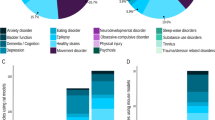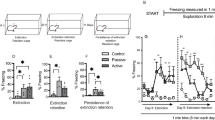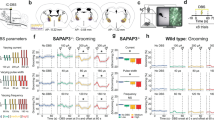Abstract
Although medications and psychotherapy are often effective for the treatment of posttraumatic stress disorder (PTSD), 20–30% of patients do not respond to these conventional therapies. In psychiatry, DBS has been either approved or is currently under investigation for different disorders. At present, whether DBS may be used to treat PTSD remains unknown. Preclinical research may provide the scientific rationale for helping conceive and further improve such trials. Some of the animal models commonly used to date are more suitable for investigating mechanisms of anxiety and fear than the long-lasting behavior that characterized PTSD. That said, mechanisms and neurocircuits involved in paradigms such as fear conditioning and extinction share several common features with those of PTSD. In this article, we review preclinical studies in which electrical stimulation has been delivered to animal models of PTSD-like behavior. In those studies, commonly targeted regions were the basolateral amygdala, ventral striatum, hippocampus, and prefrontal cortex. Overall, stimulation delivered at high frequencies to most of these targets improved fear extinction and anxiety-like behavior. Though further research is certainly needed, promising findings from DBS studies in animals are encouraging and suggest a positive future perspective for the field.
Similar content being viewed by others
Log in or create a free account to read this content
Gain free access to this article, as well as selected content from this journal and more on nature.com
or
References
Amano T, Unal CT, Pare D (2010). Synaptic correlates of fear extinction in the amygdala. Nat Neurosci 13: 489–494.
Andero R, Ressler KJ (2012). Fear extinction and BDNF: translating animal models of PTSD to the clinic. Genes Brain Behav 11: 503–512.
Bambico FR, Bregman T, Diwan M, Li J, Darvish-Ghane S, Li Z et al (2015). Neuroplasticity-dependent and -independent mechanisms of chronic deep brain stimulation in stressed rats. Transl Psychiatry 5: e674.
Burgos-Robles A, Vidal-Gonzalez I, Quirk GJ (2009). Sustained conditioned responses in prelimbic prefrontal neurons are correlated with fear expression and extinction failure. J Neurosci 29: 8474–8482.
Cleren C, Tallarida I, Guiniec EL, Janin F, Nachon O, Canini F et al (2013). Low-frequency stimulation of the ventral hippocampus facilitates extinction of contextual fear. Neurobiol Learn Mem 101: 39–45.
Deschaux O, Motanis H, Spennato G, Moreau JL, Garcia R (2011). Re-emergence of extinguished auditory-cued conditioned fear following a sub-conditioning procedure: effects of hippocampal and prefrontal tetanic stimulations. Neurobiol Learn Mem 95: 510–518.
Deschaux O, Thevenet A, Spennato G, Arnaud C, Moreau JL, Garcia R (2010). Low-frequency stimulation of the hippocampus following fear extinction impairs both restoration of rapid eye movement sleep and retrieval of extinction memory. Neuroscience 170: 92–98.
Do-Monte FH, Manzano-Nieves G, Quinones-Laracuente K, Ramos-Medina L, Quirk GJ (2015). Revisiting the role of infralimbic cortex in fear extinction with optogenetics. J Neurosci 35: 3607–3615.
Do-Monte FH, Rodriguez-Romaguera J, Rosas-Vidal LE, Quirk GJ (2013). Deep brain stimulation of the ventral striatum increases BDNF in the fear extinction circuit. Front Behav Neurosci 7: 102.
Eysenck HJ (1979). Behavioral therapy and the philosophers. Behav Res Ther 17: 511–514.
Farinelli M, Deschaux O, Hugues S, Thevenet A, Garcia R (2006). Hippocampal train stimulation modulates recall of fear extinction independently of prefrontal cortex synaptic plasticity and lesions. Learn Mem 13: 329–334.
Florence G, Sameshima K, Fonoff ET, Hamani C (2015). Deep brain stimulation: more complex than the inhibition of cells and excitation of fibers. Neuroscientist (e-pub ahead of print).
Foa EB (2000). Psychosocial treatment of posttraumatic stress disorder. J Clin Psychiatry 61 (Suppl 5): 43–48 (discussion 49–51).
Garcia R, Spennato G, Nilsson-Todd L, Moreau JL, Deschaux O (2008). Hippocampal low-frequency stimulation and chronic mild stress similarly disrupt fear extinction memory in rats. Neurobiol Learn Mem 89: 560–566.
Goshen I, Brodsky M, Prakash R, Wallace J, Gradinaru V, Ramakrishnan C et al (2011). Dynamics of retrieval strategies for remote memories. Cell 147: 678–689.
Hamani C, Diwan M, Macedo CE, Brandao ML, Shumake J, Gonzalez-Lima F et al (2010). Antidepressant-like effects of medial prefrontal cortex deep brain stimulation in rats. Biol Psychiatry 67: 117–124.
Hamani C, Temel Y (2012). Deep brain stimulation for psychiatric disease: contributions and validity of animal models. Sci Transl Med 4: 142rv148.
Hashimoto T, Elder CM, Okun MS, Patrick SK, Vitek JL (2003). Stimulation of the subthalamic nucleus changes the firing pattern of pallidal neurons. J Neurosci 23: 1916–1923.
Kheirbek MA, Drew LJ, Burghardt NS, Costantini DO, Tannenholz L, Ahmari SE et al (2013). Differential control of learning and anxiety along the dorsoventral axis of the dentate gyrus. Neuron 77: 955–968.
Langevin JP, De Salles AA, Kosoyan HP, Krahl SE (2010). Deep brain stimulation of the amygdala alleviates post-traumatic stress disorder symptoms in a rat model. J Psychiatr Res 44: 1241–1245.
Langevin JP, Koek RJ, Schwartz HN, Chen JW, Sultzer DL, Mandelkern MA et al (2015). Deep brain stimulation of the basolateral amygdala for treatment-refractory posttraumatic stress disorder. Biol Psychiatry (e-pub ahead of print).
Laurent V, Westbrook RF (2009). Inactivation of the infralimbic but not the prelimbic cortex impairs consolidation and retrieval of fear extinction. Learn Mem 16: 520–529.
Liu X, Ramirez S, Pang PT, Puryear CB, Govindarajan A, Deisseroth K et al (2012). Optogenetic stimulation of a hippocampal engram activates fear memory recall. Nature 484: 381–385.
Lovett-Barron M, Kaifosh P, Kheirbek MA, Danielson N, Zaremba JD, Reardon TR et al (2014). Dendritic inhibition in the hippocampus supports fear learning. Science 343: 857–863.
Lozano AM, Dostrovsky J, Chen R, Ashby P (2002). Deep brain stimulation for Parkinson's disease: disrupting the disruption. Lancet Neurol 1: 225–231.
Maren S, Quirk GJ (2004). Neuronal signalling of fear memory. Nat Rev Neurosci 5: 844–852.
Maroun M, Kavushansky A, Holmes A, Wellman C, Motanis H (2012). Enhanced extinction of aversive memories by high-frequency stimulation of the rat infralimbic cortex. PLoS One 7: e35853.
Milad MR, Quirk GJ (2002). Neurons in medial prefrontal cortex signal memory for fear extinction. Nature 420: 70–74.
Milad MR, Quirk GJ (2012). Fear extinction as a model for translational neuroscience: ten years of progress. Annu Rev Psychol 63: 129–151.
Milad MR, Vidal-Gonzalez I, Quirk GJ (2004). Electrical stimulation of medial prefrontal cortex reduces conditioned fear in a temporally specific manner. Behav Neurosci 118: 389–394.
Moser A, Gieselberg A, Ro B, Keller C, Qadri F (2003). Deep brain stimulation: response to neuronal high frequency stimulation is mediated through GABA(A) receptor activation in rats. Neurosci Lett 341: 57–60.
Nachon O, Cleren C, Husson S, Huguet C, Auclair J, Faure S et al (2014). Prefrontal tetanic stimulation, following fear reconditioning, facilitates expression of previously acquired extinction. Neurobiol Learn Mem 113: 62–68.
Namburi P, Beyeler A, Yorozu S, Calhoon GG, Halbert SA, Wichmann R et al (2015). A circuit mechanism for differentiating positive and negative associations. Nature 520: 675–678.
Ranck JB Jr .(1975). Which elements are excited in electrical stimulation of mammalian central nervous system: a review. Brain Res 98: 417–440.
Rodriguez-Romaguera J, Do Monte FH, Quirk GJ (2012). Deep brain stimulation of the ventral striatum enhances extinction of conditioned fear. Proc Natl Acad Sci USA 109: 8764–8769.
Rodriguez-Romaguera J, Do-Monte FH, Tanimura Y, Quirk GJ, Haber SN (2015). Enhancement of fear extinction with deep brain stimulation: evidence for medial orbitofrontal involvement. Neuropsychopharmacology 40: 1726–1733.
Sajdyk TJ, Shekhar A (1997). Excitatory amino acid receptors in the basolateral amygdala regulate anxiety responses in the social interaction test. Brain Res 764: 262–264.
Saldivar-Gonzalez JA, Posadas-Andrews A, Rodriguez R, Gomez C, Hernandez-Manjarrez ME, Ortiz-Leon S et al (2003). Effect of electrical stimulation of the baso-lateral amygdala nucleus on defensive burying shock probe test and elevated plus maze in rats. Life Sci 72: 819–829.
Sanders SK, Shekhar A (1995a). Anxiolytic effects of chlordiazepoxide blocked by injection of GABAA and benzodiazepine receptor antagonists in the region of the anterior basolateral amygdala of rats. Biol Psychiatry 37: 473–476.
Sanders SK, Shekhar A (1995b). Regulation of anxiety by GABAA receptors in the rat amygdala. Pharmacol Biochem Behav 52: 701–706.
Senn V, Wolff SB, Herry C, Grenier F, Ehrlich I, Grundemann J et al (2014). Long-range connectivity defines behavioral specificity of amygdala neurons. Neuron 81: 428–437.
Sierra-Mercado D, Padilla-Coreano N, Quirk GJ (2011). Dissociable roles of prelimbic and infralimbic cortices, ventral hippocampus, and basolateral amygdala in the expression and extinction of conditioned fear. Neuropsychopharmacology 36: 529–538.
Stidd DA, Vogelsang K, Krahl SE, Langevin JP, Fellous JM (2013). Amygdala deep brain stimulation is superior to paroxetine treatment in a rat model of posttraumatic stress disorder. Brain Stimul 6: 837–844.
Sui L, Huang S, Peng B, Ren J, Tian F, Wang Y (2014). Deep brain stimulation of the amygdala alleviates fear conditioning-induced alterations in synaptic plasticity in the cortical-amygdala pathway and fear memory. J Neural Transm 121: 773–782.
Tovote P, Fadok JP, Luthi A (2015). Neuronal circuits for fear and anxiety. Nat Rev Neurosci 16: 317–331.
Tye KM, Prakash R, Kim SY, Fenno LE, Grosenick L, Zarabi H et al (2011). Amygdala circuitry mediating reversible and bidirectional control of anxiety. Nature 471: 358–362.
VanElzakker MB, Dahlgren MK, Davis FC, Dubois S, Shin LM (2014). From Pavlov to PTSD: the extinction of conditioned fear in rodents, humans, and anxiety disorders. Neurobiol Learn Mem 113: 3–18.
Vidal-Gonzalez I, Vidal-Gonzalez B, Rauch SL, Quirk GJ (2006). Microstimulation reveals opposing influences of prelimbic and infralimbic cortex on the expression of conditioned fear. Learn Mem 13: 728–733.
Vouimba RM, Garcia R, Jaffard R (1999). Pretraining tetanic fimbrial stimulation impairs the expression but not the acquisition of contextual fear conditioning in mice. Neuroscience 93: 869–876.
Wolff SB, Grundemann J, Tovote P, Krabbe S, Jacobson GA, Muller C et al (2014). Amygdala interneuron subtypes control fear learning through disinhibition. Nature 509: 453–458.
Zheng X, Deschaux O, Lavigne J, Nachon O, Cleren C, Moreau JL et al (2013). Prefrontal high-frequency stimulation prevents sub-conditioning procedure-provoked, but not acute stress-provoked, reemergence of extinguished fear. Neurobiol Learn Mem 101: 33–38.
Acknowledgements
We thank Danilo Barbosa for the illustrations in Figures 1 and 3. A list of references not included in the main text may be found in the Supplementary Materials.
Author information
Authors and Affiliations
Corresponding author
Additional information
Supplementary Information accompanies the paper on the Neuropsychopharmacology website
Supplementary information
Rights and permissions
About this article
Cite this article
Reznikov, R., Binko, M., Nobrega, J. et al. Deep Brain Stimulation in Animal Models of Fear, Anxiety, and Posttraumatic Stress Disorder. Neuropsychopharmacol 41, 2810–2817 (2016). https://doi.org/10.1038/npp.2016.34
Received:
Revised:
Accepted:
Published:
Issue date:
DOI: https://doi.org/10.1038/npp.2016.34
This article is cited by
-
Serotonin 5-HT1B receptors mediate the antidepressant- and anxiolytic-like effects of ventromedial prefrontal cortex deep brain stimulation in a mouse model of social defeat
Psychopharmacology (2022)
-
Treating Post-traumatic Stress Disorder with Neuromodulation Therapies: Transcranial Magnetic Stimulation, Transcranial Direct Current Stimulation, and Deep Brain Stimulation
Neurotherapeutics (2020)
-
Prefrontal Cortex Deep Brain Stimulation Improves Fear and Anxiety-Like Behavior and Reduces Basolateral Amygdala Activity in a Preclinical Model of Posttraumatic Stress Disorder
Neuropsychopharmacology (2018)
-
Cotinine: A Therapy for Memory Extinction in Post-traumatic Stress Disorder
Molecular Neurobiology (2018)



